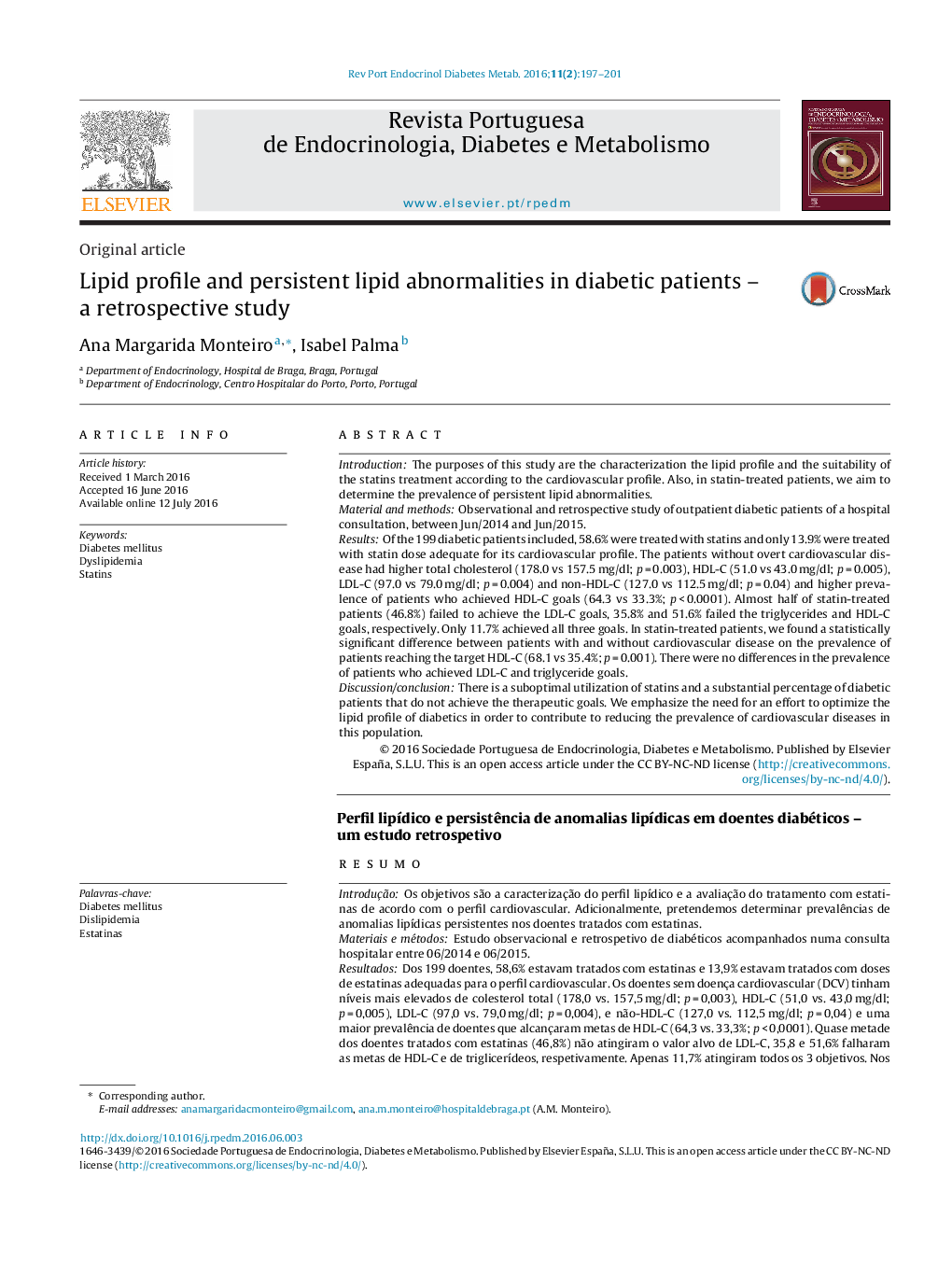| Article ID | Journal | Published Year | Pages | File Type |
|---|---|---|---|---|
| 3278197 | Revista Portuguesa de Endocrinologia, Diabetes e Metabolismo | 2016 | 5 Pages |
IntroductionThe purposes of this study are the characterization the lipid profile and the suitability of the statins treatment according to the cardiovascular profile. Also, in statin-treated patients, we aim to determine the prevalence of persistent lipid abnormalities.Material and methodsObservational and retrospective study of outpatient diabetic patients of a hospital consultation, between Jun/2014 and Jun/2015.ResultsOf the 199 diabetic patients included, 58.6% were treated with statins and only 13.9% were treated with statin dose adequate for its cardiovascular profile. The patients without overt cardiovascular disease had higher total cholesterol (178.0 vs 157.5 mg/dl; p = 0.003), HDL-C (51.0 vs 43.0 mg/dl; p = 0.005), LDL-C (97.0 vs 79.0 mg/dl; p = 0.004) and non-HDL-C (127.0 vs 112.5 mg/dl; p = 0.04) and higher prevalence of patients who achieved HDL-C goals (64.3 vs 33.3%; p < 0.0001). Almost half of statin-treated patients (46.8%) failed to achieve the LDL-C goals, 35.8% and 51.6% failed the triglycerides and HDL-C goals, respectively. Only 11.7% achieved all three goals. In statin-treated patients, we found a statistically significant difference between patients with and without cardiovascular disease on the prevalence of patients reaching the target HDL-C (68.1 vs 35.4%; p = 0.001). There were no differences in the prevalence of patients who achieved LDL-C and triglyceride goals.Discussion/conclusionThere is a suboptimal utilization of statins and a substantial percentage of diabetic patients that do not achieve the therapeutic goals. We emphasize the need for an effort to optimize the lipid profile of diabetics in order to contribute to reducing the prevalence of cardiovascular diseases in this population.
ResumoIntroduçãoOs objetivos são a caracterização do perfil lipídico e a avaliação do tratamento com estatinas de acordo com o perfil cardiovascular. Adicionalmente, pretendemos determinar prevalências de anomalias lipídicas persistentes nos doentes tratados com estatinas.Materiais e métodosEstudo observacional e retrospetivo de diabéticos acompanhados numa consulta hospitalar entre 06/2014 e 06/2015.ResultadosDos 199 doentes, 58,6% estavam tratados com estatinas e 13,9% estavam tratados com doses de estatinas adequadas para o perfil cardiovascular. Os doentes sem doença cardiovascular (DCV) tinham níveis mais elevados de colesterol total (178,0 vs. 157,5 mg/dl; p = 0,003), HDL-C (51,0 vs. 43,0 mg/dl; p = 0,005), LDL-C (97,0 vs. 79,0 mg/dl; p = 0,004), e não-HDL-C (127,0 vs. 112,5 mg/dl; p = 0,04) e uma maior prevalência de doentes que alcançaram metas de HDL-C (64,3 vs. 33,3%; p < 0,0001). Quase metade dos doentes tratados com estatinas (46,8%) não atingiram o valor alvo de LDL-C, 35,8 e 51,6% falharam as metas de HDL-C e de triglicerídeos, respetivamente. Apenas 11,7% atingiram todos os 3 objetivos. Nos doentes tratados com estatinas, encontramos diferença estatisticamente significativa entre os doentes com e sem DCV, sobre a prevalência de atingimento do alvo HDL-C (68,1 vs. 35,4%, p = 0,001). Não houve diferenças na prevalência de doentes que atingiram os objetivos de LDL-C e triglicerídeos.Discussão e conclusãoVerifica-se uma utilização subótima das estatinas e uma percentagem substancial de diabéticos que não alcançam os objetivos terapêuticos. Salienta-se a necessidade de um esforço para otimizar o perfil lipídico dos diabéticos de forma a contribuir para a diminuição da prevalência de DCV nesta população.
